The backbone of the Chinese Navy in the Cold War
The “Luda” class (NATO) or Type 051 destroyer (Chinese designation) were the first ocean-going warships by the PRC and first Chinese ship to be fitted with an integrated combat direction system. They formed until the early 2000s the backbone of the Chinese Navy. They were laid down from 1966 and completed from 1972 to 1981 at a time of political uncertainty, having just break relations with USSR and starting to open to the West. At first glance, the ships looked like souped-up versions of the Soviet Tallinn class, a 1950s design, mixing elements of the Neustrashimy and kotlin designs. By their appearance, alternating superstructures, funnels and missile launchers they recalled WW2 classic destroyer designs rather than modern missile destroyers. By the time they were unveiled indeed, the Soviet Navy already works on the Sovremennyy and the Americans had the Spruance, both much more advanced designs.
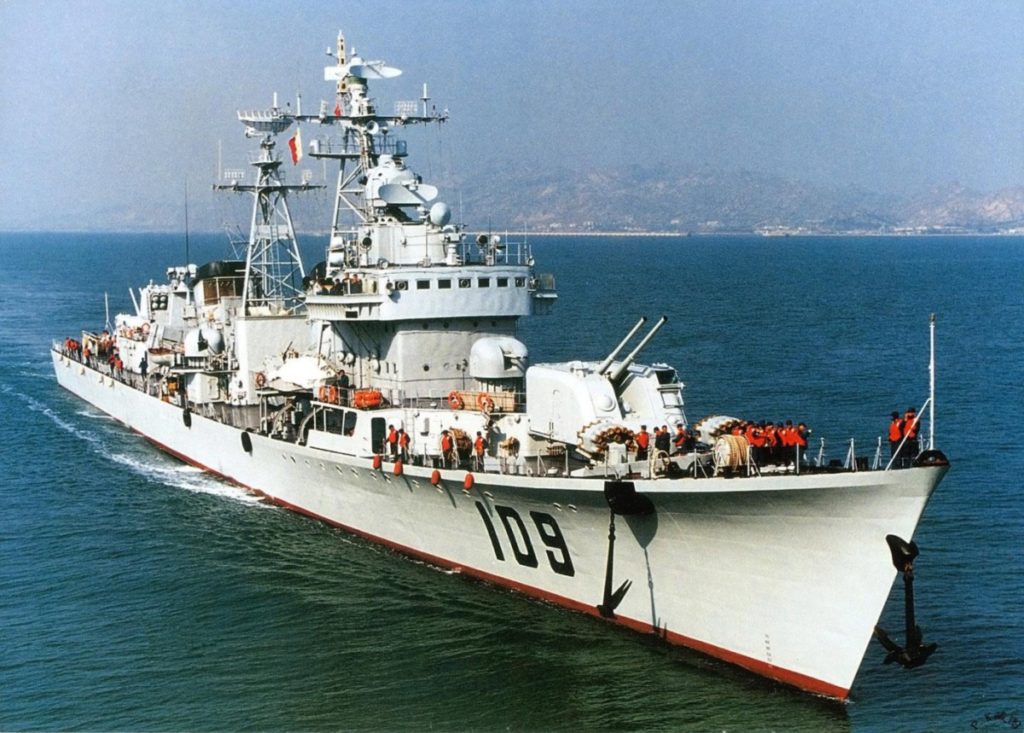
Luda Type 051 DDG-109 Kaifeng (cdts sinodefence blog)
Genesis of the “Luda”
These ships were named by NATO after their building shipyards (Dalian and Lushün), where observation satellites first spotted them, but they were also delivered by the Zhonghua Shipyards. Given the scope of the effort (16 ships in ten years) it was an unprecedented rise in capabilities, both on the military and industrial sides, and a good preview of what was to come. In the 1960s the only destroyers in service were the Anshan class, which were unsuitable for long-range ocean recovery missions (to retrieve Chinese rockets, part of the space program). The 701 institute was ordered to develop the first Chinese guided missile destroyer. They started on plans (passed before 1969) of the Soviet Kotlin class, improved in many ways.
The general designers were Mr. Li Fuli and Pan Jingfu of the 701st (Research) Institute of the 7th Academy. 1240 equipment systems (110 new domestic ones) were ordered from a dozen establishments under supervision by the Ministry of Industry. The final design was approved in 1967, and construction started the next year in 1968. A total of 16 Type 051 destroyers were delivered until 1991. As these lines are written, 9 are still in service, but this was only possible through massive refits which began in the 1990s (see later).

A port beam view of the Chinese Navy Luda class guided missile destroyer XIAN (DDG 106).
Design of the “Luda”
These ships looked quite similar to the 1950s Kotlin class, a flush-deck hull with elements of superstructure alternating with the massive missile launchers.
Armament
The main armament comprised semi-automated 130 mm turrets superficially similar to the Soviet model and able of a high rate of fire inluding for AA purposes. The rest of the AA weaponry comprised manual twin barrelled mounts of 57mm (eight) or four twin 37mm and two twin 25 mm mounts. Also their ASW capability was provided by two FQF-2500 Rocket Launchers, two to four grenade throwers and two deep-charges racks at the rear, and rails to carry and lay mines.
On the primary batch, the Type 051 standard missile was the SY-1 developed by 713th and 701st Research Institutes and 3rd Academy (7th Ministry) as a naval version of the HY-1 (Chief designers Mr. Xianzhang (谢宪章) and Yao Yuebin (姚跃滨)) which had the idea of instead of separating the launching and loading systems, had both fused into one single container, designated Type 7222. Electromagnetic compatibility however caused prematre missiles launches and accident, only resolved in the early 1980s, resulting in 1982 escort SSBN testings not mounting the missiles at all.
But its centerpiece was the two triple SY-2 SSM launchers, one behind each funnel with a 360° traverse. The SY-2 missiles (For Shang You or SY-series) were derivatived of the Soviet P-15 Termit missile. They were bulky, low-tech missiles depending on extensive ship-borne electronics, and cause some power cuts problems on the smaller Anshan class. These missiles were produced at Factory 320 (Nanchang). These HY-1/HY-2 were replaced by the YJ-83 (C-803) missile in the 1990s, while old manual AA mounts were replaced by automatic ones and this was complemented by an 8-cell HQ-7 Surface-to-air missile system.
SY-2 (Fei Long) NATO Codename CSS-N-5 SABBOT:
The SY-2 had a solid fuel rocket engine (the SY-1 had an instable liquid fuel one) which helped reduce its size and weight but provided also greater range. However the tradeoff was a smaller warhead, compensated by increased effectiveness. A time-delayed semi-armour-piercing high-explosive design was indeed tailor-made for it. The later SY-2A had a stratched body. It was confounded often with the the HY-2, a larger, purely land-based missile, stretched body HY-1 with a nose radar seeker, a pair of mid-mounted delta wings and three tail control surfaces. It had a liquid-fuel rocket motor complemented by a solid rocket booster under the fuselage and an altitude ranging from 1,000m (cruising mode), 100~300m before (final ride) and switching on radarwhile diving to 8m before hitting.
The SY-2 was 6 m x 0.54 m with a wingspan of 1.7 m, and weighted 1,720 kg with a 365 kgs warhead of shape charged high-explosive. It can fly at Mach 0.9 up to 130 km at an altitude of 20 metre and was guided by inertial and active radar. Its single kill probability was 70%.
Modernized versions:
HQ-7 (FM-80) Naval: This was basically a copy of the French Crotale SAM, the standard short-range air-defense missile of the Chinese Navy from the 1990s. It was operated by 8-cell launchers, with stores of 16 missiles with a manual or auto-loader retracted under the deck. It used the Type 360S E/F-band Doppler radar. Detection range was 18.4 km. Fire control was provided by a ZJK-4 (Thomson-CSF TAVITAC) combat management system capable of processing up to 30 targets and tracking 12 targets simultaneously.

Destroyers of Luda class
Propulsion
These 3700 tonnes ships were fitted with two steam turbines for a total of 72,000 shp (53,700 kW) and nominal top speed of 32 knots (59 km/h) and operational range of 2,970 miles. Although these speeds were developed to chase modern diesel-electric submarines and nuclear SNAs, it proved eventually a liability for ASW warfare and for the noise and vibrations that impacted negatively the capabilities of the sonar. The lack of helicopter ASW capability also hampered this serie (this was remedied only on one ships of the Luda-II class).
Electronics
This first batch of 8 ships was the firstwith a bow-mounted sonar. Instead of the original Tamir-11(MG-11 Stag Hoof) search light sonar the Chinese developed the SJD-1 (Type 601) low frequency (LF), with a large aperture and cylindrical array. It had a range of 6 nautical miles and more. It was jointly developed by 706th Research Institute, 726th & 461th Factories, and only replaced by the SJD-2 in the late 1980s.
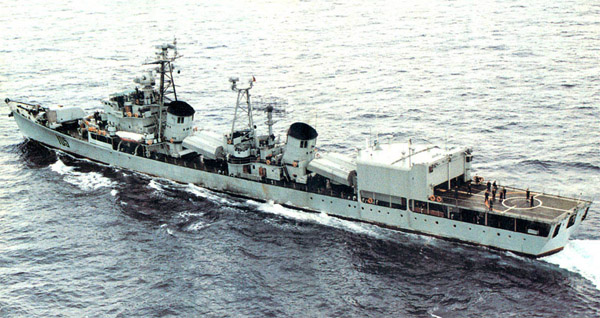
Luda II
Luda sub-types
The “Luda” class was subdivided into new sub-classes and later retrofitted modifications:
-7 ships of the Type 051
-6 ships of Type 051D
-2 ships of Type 051Z.
Upgrades:
-Luda II modifications with rear helicopter deck and hangar, new electronics for ASW warfare.
-Luda III modifications (Type 051G, G1 and G2)
-Luda IV upgrade (Type 051DT): 2 ships
Type 051D
This 2nd batch of 6 ships were denominated D for Dingxing or finalized design, the fifferences laying in modernized electronics.
New Sonar: The SJD-1 sonar inaccurate locations of targets and errors failed to give fire solutions so an additional high frequency active attack sonar SJD-N (Type 675 array) was fitted on this serie and later retroffited in all Luda class destroyers.
Depth charge racks eliminated and replaced as the two mine rails modified to also function astake their place, with a capability of 28 mines or 42 depth charges.
New ASW combat system:
To overhaul their air and submarine attack bubble, the Type 051D had a mixtures of fittings over time, to the point of making each ship specific, also being dependent on imports but providing expertise. Therefore a much more capable specialized ASW fire control system was developed designated SIASWFCS (Shipborne Integrated Anti-Submarine FCS) which linked onboard sensors and ASW weaponry, identified priority targets and simultaneously engage 2 targets by providing fire solutions either to torpedo tubes, ASW rocket launcher, mortar, grenades on rails, and later ASW missiles. This system quicky became standard on all PLAN surface ships, later with increasing targets managements and capablities.
Type 051Z
This third batch comprised two ships, the Z for Zhihui, meaning command. Design work starting in April 1977 and as completed in late 1978. Thes ships had the first indigenously developed passive phased array radar, called the Type 381 Radar, and the first to have a modern combat data system designated ZKJ-1 by Nanjing Marine Radar Research Institute and 709th Research Institute. Its development took 13 years by Mr. Qin Xuechang. Naval tests were completed in 1979 and land tests against aerial targets in 1980, and installed from July 1980 for the final tests. The combat information center Type 672-II (NATO Poseidon-1) had three electronics cabinets and six display consoles, but limited computational power. It was installed in only one 051Z destroyer at Dalian (110), the second 051Z destroyer Hefei (132), being given a British equivalent. This ZKJ-2 combat direction system. Alternatively the Italian-origin ZKJ-3 or IPN-10 was installed on some Luda III ships. This system comprised a Racal Marine Radar CTC-1629 which could simultaneously track 20 targets, working on IEEE/ITU standard.
Luda II
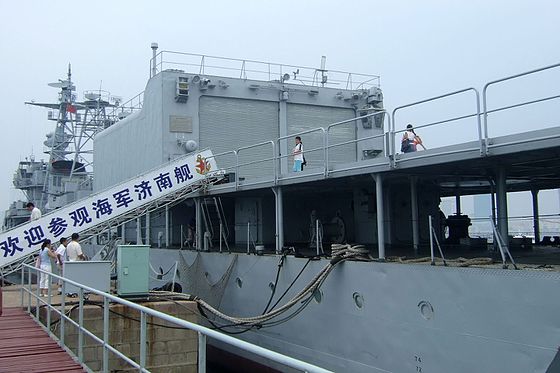
Luda II Jinan (105) rear view bridge and hangar for two Harbin Z-9C ASW/SAR helicopters
Only two destroyers were modified for increasing ASW capabilities and C3I duties. The whole rear was cleaned off and received an helicopter deck and hangar space for 2 helicopters. Its ZKJ-1 combat data system was upgraded with the Type 911 computer counting ruggeddized Type 991 microprocessors, becomong a standard retrofitted in all Luda ships. More recently it has been superseded by the ZKJ-4, a copy of Thomson-CSF TAVITAC system.
Luda III – Type 051G
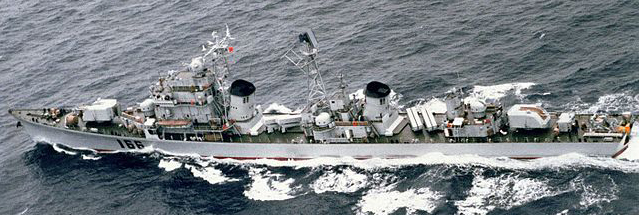

Luda III Zuhai
This serie counted only individual ships testing various systems. This was originally a single ship, but modifications were later retrofitted on other Luda class DDs.
Type 051G: Mid-1980s ASW systems upgrade, by introducing foreign equipment. Italy was selected to provide a replacement for the simple CTC-1629/ZKJ-1 called SADOC 2, export version of IPN-10 delivered in 1985. This was comlemented by another Italian system called DE-1164 integrated sonar (itself derived from Raytheon AN/SQS-56 sonar). The DE-1160 hull-mounted sonar had a maximum range of 20 km. The DE-1163 is a variable depth sonar (Range 50 km+), the first Chinese sonar to integrate HMS & VDS. It was connected by an Italian ILAS triple torpedo tubes using A244-S light weight ASW torpedoes. Performance of DE-1164 sonar was somewhat hampared by the old design, especially the the steam propulsion system and its excessive noise and vibrations forcing to very low speed for better performances. After nearly two years of trials these systems were removed for reverse engineering ending on Jinan (105) and giving expertise to create the Chinese ZKJ-3 combat data system and SJD-7 sonar.
Type 051D: Its development started in November 1983, but not completed until 1986. This attention went on Zhanjiang (165) launched on Aug 1, 1988 to serve with the South Sea Fleet. it focused on extending the ASW platform capabilities and end with a major redesign of SJD-2 system. The SJD-N was replaced by SJD-4, allowing submarine detections up to 18 knots (33 km/h) even in heavy seas, but still without VDS capabilities. Another improvement was the use of HY-1J AShM which had a lower cruise altitude, higher accuracy and better jamming resistance, and moreover a range jumping from 10 km to 95 km. The enclosed Type 76A twin 37 mm naval guns automated were also adopted and their high rate of fire meant they can be used as CIWS. An enclosed bridge was also adopted.
Electronics were upgraded with a Type 381 passive phased array radar, Type 347 fire control radar and Type 751 navigational radar, plus Type 352I radar for surface search and the Type 825 electronic warfare system. This new Frenc-origin combat data system allowed simultaneous tracking of 60 targets plus 60 more manually, possibly based on Thomson-CSF TAVITAC or ZKJ-4. To get accustomed to these new Western systems the crew went through extensive training for four years before reaching full potential in 1993.
Type 051G2: Work concentrated on the Zhuhai (166), completed in November 1991. Four twin YJ-8 (C-801) missiles were installed as well as two triple Whitehead ILAS torpedo launchers at either sides. The hull draught was increased to 4.66 meter, but the length was reduced by 4 meters and crew reduced to 280. Also HQ-7 SAM (Crotale), and four YJ-83 (C-802a) SSMs were later adopted.
Electronic wise, an EFR-1 Rice Lamp fire-control radar was also installed as well as the Type 517 Radar for long range air search and Type 344 fire-control radar for the guns.
This 051G2 destroyer was primarily used to test noise and vibration reduction systems, to work with a SJD-7 sonar, a Chinese version of Italian DE-1164 sonar. There is no certitude for the VDS system. The combat data system is the ZKJ-3 (ZKJ-III) (Italian IPN-10, SADOC 2). This system can nominally simultaneously track 200 targets, but limited by the Chinese data link capabilities, for which a domestic data link was developed, designed by the 724th Research Institute. This system of 1988 greatly helped to develop the ZKJ-4, close to the French TAVITAC combat data system with the capability to track 200 targets simultaneously.
Luda IV/V – Type 051DT
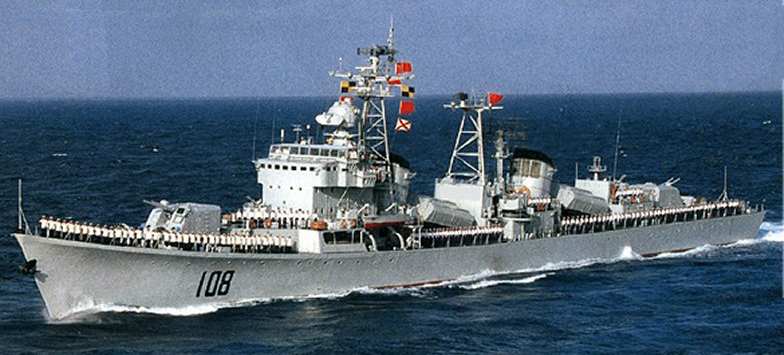
Luda V
This was a general upgrade for a variety of ships, mid-life upgrades on several of its Luda class destroyers. Some ships have been upgraded with a, with for some ships the new ZKJ-4A-3 combat data system, HQ-7 (Crotale SAM), Type 76A dual 37 mm automatic AA guns, and 16 YJ-83 (C-802a) anti-ship missiles or alternative CY series ASW missiles. This upgrade cncerned the Kaifeng (109) and Dalian (110) but these upgrades are ongoing for the 6 remaining ships.
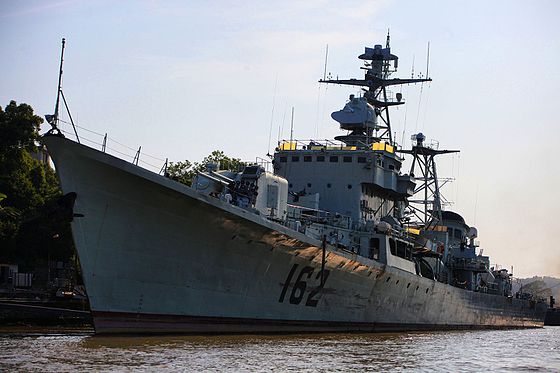
Nanning – Luda IV DDG-152
Read more
https://en.wikipedia.org/wiki/Type_051_destroyer
http://www.military-today.com/navy/luda_class.htm
http://enacademic.com/dic.nsf/enwiki/839752
Conway’s all the world fighting ships 1947-1990

 Latest Facebook Entry -
Latest Facebook Entry -  X(Tweeter) Naval Encyclopedia's deck archive
X(Tweeter) Naval Encyclopedia's deck archive Instagram (@navalencyc)
Instagram (@navalencyc)





 French Navy
French Navy Royal Navy
Royal Navy Russian Navy
Russian Navy Armada Espanola
Armada Espanola Austrian Navy
Austrian Navy K.u.K. Kriegsmarine
K.u.K. Kriegsmarine Dansk Marine
Dansk Marine Nautiko Hellenon
Nautiko Hellenon Koninklije Marine 1870
Koninklije Marine 1870 Marinha do Brasil
Marinha do Brasil Osmanlı Donanması
Osmanlı Donanması Marina Do Peru
Marina Do Peru Marinha do Portugal
Marinha do Portugal Regia Marina 1870
Regia Marina 1870 Nihhon Kaigun 1870
Nihhon Kaigun 1870 Preußische Marine 1870
Preußische Marine 1870 Russkiy Flot 1870
Russkiy Flot 1870 Svenska marinen
Svenska marinen Søværnet
Søværnet Union Navy
Union Navy Confederate Navy
Confederate Navy Armada de Argentina
Armada de Argentina Imperial Chinese Navy
Imperial Chinese Navy Marinha do Portugal
Marinha do Portugal Mexico
Mexico Kaiserliche Marine
Kaiserliche Marine 1898 US Navy
1898 US Navy Sovietskiy Flot
Sovietskiy Flot Royal Canadian Navy
Royal Canadian Navy Royal Australian Navy
Royal Australian Navy RNZN Fleet
RNZN Fleet Chinese Navy 1937
Chinese Navy 1937 Kriegsmarine
Kriegsmarine Chilean Navy
Chilean Navy Danish Navy
Danish Navy Finnish Navy
Finnish Navy Hellenic Navy
Hellenic Navy Polish Navy
Polish Navy Romanian Navy
Romanian Navy Turkish Navy
Turkish Navy Royal Yugoslav Navy
Royal Yugoslav Navy Royal Thai Navy
Royal Thai Navy Minor Navies
Minor Navies Albania
Albania Austria
Austria Belgium
Belgium Columbia
Columbia Costa Rica
Costa Rica Cuba
Cuba Czechoslovakia
Czechoslovakia Dominican Republic
Dominican Republic Haiti
Haiti Hungary
Hungary Honduras
Honduras Estonia
Estonia Iceland
Iceland Eire
Eire Equador
Equador Iran
Iran Iraq
Iraq Latvia
Latvia Liberia
Liberia Lithuania
Lithuania Mandchukuo
Mandchukuo Morocco
Morocco Nicaragua
Nicaragua Persia
Persia San Salvador
San Salvador Sarawak
Sarawak Uruguay
Uruguay Venezuela
Venezuela Zanzibar
Zanzibar Warsaw Pact Navies
Warsaw Pact Navies Bulgaria
Bulgaria Hungary
Hungary

 Bundesmarine
Bundesmarine Dutch Navy
Dutch Navy Hellenic Navy
Hellenic Navy Marina Militare
Marina Militare Yugoslav Navy
Yugoslav Navy Chinese Navy
Chinese Navy Indian Navy
Indian Navy Indonesian Navy
Indonesian Navy JMSDF
JMSDF North Korean Navy
North Korean Navy Pakistani Navy
Pakistani Navy Philippines Navy
Philippines Navy ROKN
ROKN Rep. of Singapore Navy
Rep. of Singapore Navy Taiwanese Navy
Taiwanese Navy IDF Navy
IDF Navy Saudi Navy
Saudi Navy Royal New Zealand Navy
Royal New Zealand Navy Egyptian Navy
Egyptian Navy South African Navy
South African Navy






























 Ukrainian Navy
Ukrainian Navy dbodesign
dbodesign